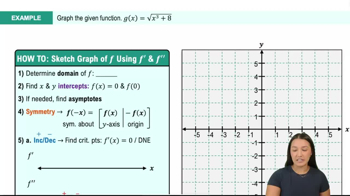Table of contents
- 0. Functions7h 52m
- Introduction to Functions16m
- Piecewise Functions10m
- Properties of Functions9m
- Common Functions1h 8m
- Transformations5m
- Combining Functions27m
- Exponent rules32m
- Exponential Functions28m
- Logarithmic Functions24m
- Properties of Logarithms34m
- Exponential & Logarithmic Equations35m
- Introduction to Trigonometric Functions38m
- Graphs of Trigonometric Functions44m
- Trigonometric Identities47m
- Inverse Trigonometric Functions48m
- 1. Limits and Continuity2h 2m
- 2. Intro to Derivatives1h 33m
- 3. Techniques of Differentiation3h 18m
- 4. Applications of Derivatives2h 38m
- 5. Graphical Applications of Derivatives6h 2m
- 6. Derivatives of Inverse, Exponential, & Logarithmic Functions2h 37m
- 7. Antiderivatives & Indefinite Integrals1h 26m
- 8. Definite Integrals4h 44m
- 9. Graphical Applications of Integrals2h 27m
- 10. Physics Applications of Integrals 2h 22m
5. Graphical Applications of Derivatives
Curve Sketching
Problem 29
Textbook Question
Graphing functions Use the guidelines of this section to make a complete graph of f.
f(x) = 3x/(x² - 1)
 Verified step by step guidance
Verified step by step guidance1
Identify the domain of the function f(x) = \( \frac{3x}{x^2 - 1} \). The denominator x² - 1 cannot be zero, so solve x² - 1 = 0 to find the values of x that are not in the domain.
Determine the vertical asymptotes by setting the denominator equal to zero and solving for x. This will give you the x-values where the function is undefined.
Find the horizontal asymptote by analyzing the behavior of f(x) as x approaches infinity or negative infinity. Since the degree of the numerator is less than the degree of the denominator, the horizontal asymptote is y = 0.
Calculate the first derivative f'(x) to find the critical points and determine intervals of increase and decrease. Use the quotient rule: \( f'(x) = \frac{(x^2 - 1)(3) - (3x)(2x)}{(x^2 - 1)^2} \). Simplify and solve f'(x) = 0 to find critical points.
Calculate the second derivative f''(x) to determine concavity and points of inflection. Use the quotient rule again on f'(x) and solve f''(x) = 0 to find potential inflection points. Analyze the sign of f''(x) to determine concavity intervals.
 Verified video answer for a similar problem:
Verified video answer for a similar problem:This video solution was recommended by our tutors as helpful for the problem above
Video duration:
15mPlay a video:
Was this helpful?
Key Concepts
Here are the essential concepts you must grasp in order to answer the question correctly.
Function Behavior
Understanding the behavior of the function involves analyzing its domain, range, and asymptotic behavior. For the function f(x) = 3x/(x² - 1), we need to identify where the function is defined and where it may have vertical asymptotes, which occur where the denominator equals zero.
Recommended video:

Graphs of Exponential Functions
Finding Asymptotes
Asymptotes are lines that the graph approaches but never touches. For rational functions like f(x) = 3x/(x² - 1), vertical asymptotes can be found by setting the denominator to zero, while horizontal asymptotes can be determined by analyzing the degrees of the numerator and denominator as x approaches infinity.
Recommended video:

Finding Limits by Direct Substitution
Critical Points and Intervals
Critical points are where the derivative of the function is zero or undefined, indicating potential local maxima, minima, or points of inflection. Analyzing these points, along with the intervals of increase and decrease, helps in sketching the overall shape of the graph and understanding its key features.
Recommended video:

Critical Points

 11:41m
11:41mWatch next
Master Summary of Curve Sketching with a bite sized video explanation from Callie
Start learning




